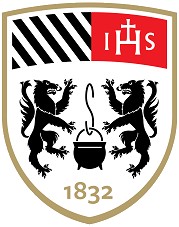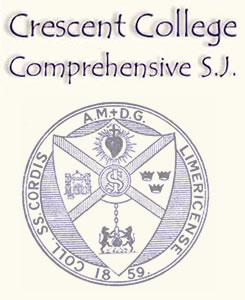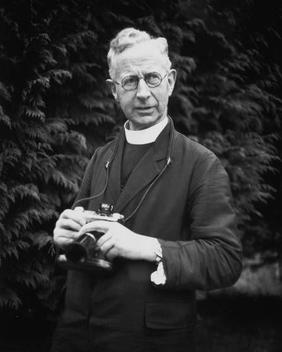
Enniscorthy is the second-largest town in County Wexford, Ireland. At the 2016 census, the population of the town and environs was 11,381. The town is located on the picturesque River Slaney and in close proximity to the Blackstairs Mountains and Ireland's longest beach, Curracloe. The town is twinned with Gimont, France. The Placenames Database of Ireland sheds no light on the origins of the town's name. It may refer either to the "Island of Corthaidh" or the "Island of Rocks". The cathedral of the Roman Catholic Diocese of Ferns is located in the town as well as an array of other historical sites such as Enniscorthy Castle and the key battle site of the 1798 Rebellion.

Belvedere College S.J. is a voluntary secondary school for boys in Dublin, Ireland. The school has numerous notable alumni in the arts, politics, sports, science, and business. Alumni and teachers at Belvedere played major roles in modern Irish literature, the standardisation of the Irish language, as well as the Irish independence movement – both the 1916 Rising and the Irish War of Independence. The school's notable alumni and former faculty include two Taoisigh, one Ceann Comhairle, several cabinet ministers, one Blessed, one Cardinal, one Archbishop, one signatory of the Proclamation of the Irish Republic, two Supreme Court Justices, one Olympic medallist, thirty Irish international rugby players and numerous notable figures in the world of the arts, academia and business. Belvedere College forms the setting for part of James Joyce's semi-autobiographical novel A Portrait of the Artist as a Young Man'
The Pioneer Total Abstinence Association of the Sacred Heart (PTAA) is an international organisation for Roman Catholic teetotalers that is based in Ireland. Its members are commonly called Pioneers. While the PTAA does not advocate prohibition, it does require of its members complete abstinence from alcoholic drink. It also encourages devotion to the Sacred Heart of Jesus as an aid to resisting the temptation of alcohol. Pioneers wear a lapel pin called a Pioneer pin with an image of the Sacred Heart, both to advertise the organisation and to alert others not to offer them alcohol. The association publishes a monthly magazine, The Pioneer.

The Battle of Vinegar Hill was a military engagement during the Irish Rebellion of 1798 on 21 June 1798 between a force of approximately 13,000 government troops under the command of Gerard Lake and 16,000 United Irishmen rebels led by Anthony Perry. The battle, a major rebel defeat, took place on 21 June 1798 on a large rebel camp on Vinegar Hill and in the streets of Enniscorthy, County Wexford where the Rebels took 11 minutes to get down from the hill led by Peggy the Black, and marked the last major attempt by the rebels to resist government forces in a pitched battle.

Crescent College Comprehensive SJ, formerly known as the College of the Sacred Heart, is a secondary school located on 40 acres (160,000 m2) of parkland at Dooradoyle, Limerick, Ireland. The college is one of a number of Jesuit schools in Ireland.
The Messenger of the Sacred Heart is a Roman Catholic periodical; the print organ of the Apostleship of Prayer, a pious association founded in nineteenth century France by the Jesuits. There are many editions in various languages, promoting devotion to the Sacred Heart of Jesus. In the late 1940s, The Messenger was banned in many Soviet Block countries.
Lambert McKenna S.J. was a Jesuit priest and writer.

William Joseph Gabriel Doyle, SJ MC, better known as Willie Doyle, was an Irish Catholic priest who was killed in action while serving as a military chaplain to the Royal Dublin Fusiliers during the First World War. He is a candidate for sainthood in the Catholic Church.
St Stanislaus College was a Jesuit boys boarding school, novitiate and philosophy school, in Tullabeg, Rahan, County Offaly. St Carthage founded a monastery of 800 monks there in 595 before founding his monastery in Lismore. The Presentation Sisters also have a convent in Rahan, Killina, which was founded at the same time as the Jesuits founded St Stanislaus College.

The Roman Catholic Bona Mors Confraternity was founded 2 October 1648, in the Church of the Gesu, Rome, by Father Vincenzo Carafa, seventh General of the Society of Jesus. In 1729 it was raised to an archconfraternity by Benedict XIII. The object of the association is to prepare its members by a well-regulated life to die in peace with God.

Francis Patrick Mary Browne, was a distinguished Irish Jesuit and a prolific photographer. His best known photographs are those of the RMS Titanic and its passengers and crew taken shortly before its sinking in 1912. He was decorated as a military chaplain during the First World War.

John Murphy was an Irish Roman Catholic priest of the Roman Catholic Diocese of Ferns, who is mainly remembered for his central role in the Irish Rebellion of 1798 in County Wexford, which is sometimes known as the Wexford Rebellion. He led the rebels to one of their initial victories over a government militia at Oulart Hill, and in the following weeks became one of the rebellion's main leaders.
Beauchamp Bagenal Harvey was a barrister and a commander of the United Irishmen in the Battle of New Ross during the 1798 Rebellion.
James Walshe was an Irish Catholic priest and bishop in Kildare and Leighlin; before becoming a bishop he was president of Carlow College, where he had previously been a professor. He was born 30 June 1803 in New Ross, County Wexford, to Philip Walshe, and his wife, Mary Walshe.
Thomas Aloysius Finlay, S.J. was an Irish Catholic priest, economist, philosopher and editor.
Peter James Kenney (1779–1841) was an Irish Jesuit priest. He founded Clongowes Wood College and was also rector of the Jesuits in Ireland. A gifted administrator, Kenney made two trips to the United States, where he established Maryland as a vice-province and set up Missouri as a separate Jesuit mission.

Alexander Aloysius "Alan" McGuckian SJ is a Roman Catholic prelate and theologian from Northern Ireland who has served as Bishop of Raphoe since 2017.
Catholic Education, an Irish Schools Trust (CEIST) is the trustee body for 107 Catholic Voluntary Secondary Schools in Ireland.

A Sacred Heart lamp is a Catholic devotional object, traditionally found in Irish homes.

Matthew Russell SJ (1834–1912) was an Irish Jesuit, known as a writer, poet and editor.










